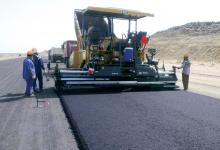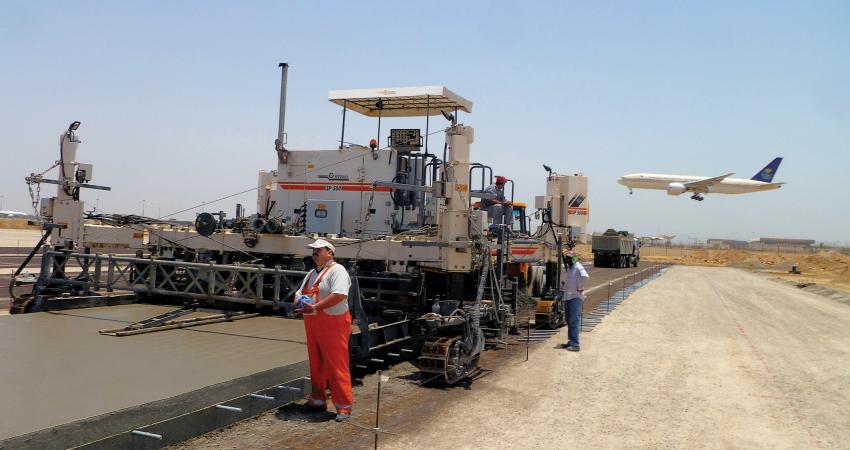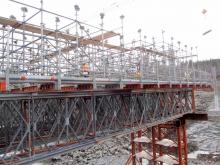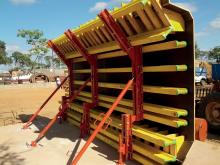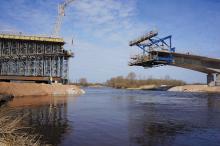A bespoke formwork solution from RMD Kwikform is playing a key role in creating the largest ever airport cast bridge deck as part of the multi-billion dollar expansion of King Abdulaziz International Airport near Jeddah, Saudi Arabia. The firm is also a leading player in the creation of arterial tunnels under the airport’s elevated roads, another key part of the project’s first phase works due for completion in 2014. Guy Woodford reports
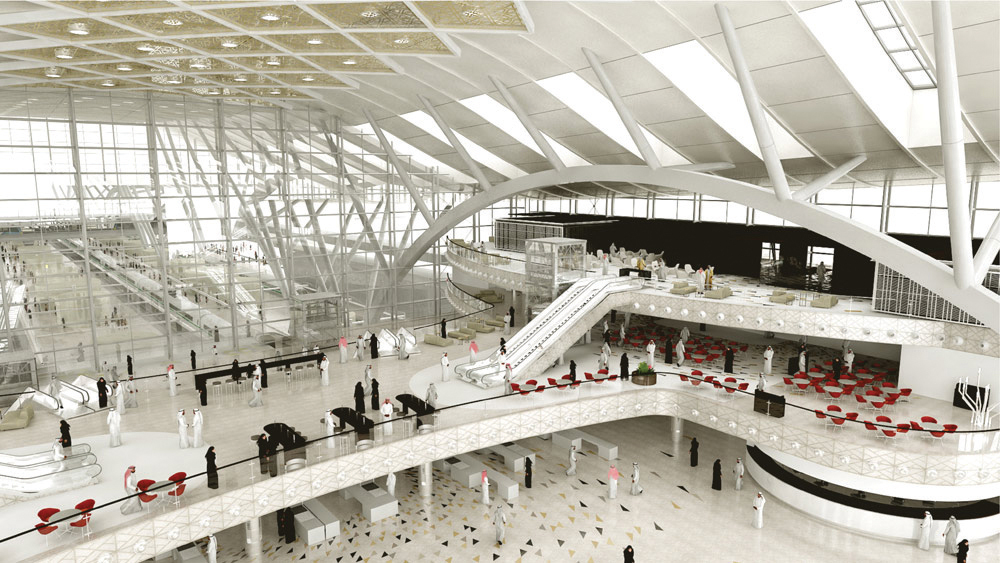
The new internal area at the airport has been designed to be light and airy as well as thermally efficient in the
sometimes tough climactic conditions
A bespoke formwork solution from RMD Kwikform is playing a key role in creating the largest ever airport cast bridge deck as part of the multi-billion dollar expansion of King Abdulaziz International Airport near Jeddah, Saudi Arabia. The firm is also a leading player in the creation of arterial tunnels under the airport’s elevated roads, another key part of the project’s first phase works due for completion in 2014. Guy Woodford reports
Spanning 15km, the new $666.43 million (SAR 2.5 billion) bridge deck at King Abdulaziz International Airport (KAIA), 19km north of the city of Jeddah, Saudi Arabia’s commercial capital, is already an impressive sight ahead of its scheduled completion at the end of 2014.
The giant bridge deck will be the main route in and out of KAIA and is a major feature of the first US$7.2 billion (SAR 27 billion) phase of the airport’s three-phase multi-million dollar expansion, set to take capacity up to 70-80 million passengers by 2035.
Known as the gateway to Islam’s holy city of Mecca and famous for its Hajj Terminal, specially built to accommodate pilgrims travelling to the annual Hajj, the current KAIA airport sees 23 million passengers travelling through it annually – with only Dubai attracting more Middle East airport passengers.
For its bespoke formwork solution for KAIA’s groundbreaking bridge deck,319 RMD Kwikform has used Rapidshor falsework, Megashor for arch support, Superslim Soldiers and Special Steel Decks fabricated by RMD, and Superslim Soldiers and GTX Beams for decks.
An RMD Kwikform spokesperson said, “We designed a specialist solution that allowed the project to move forward a lot quicker.
The Special Steel Decks were requested by the customer [Advanced Global Construction Services]. Around 90% of the decks were typical, but RMD made them in a way that they could utilise the steel decks to accommodate the remaining 10%.”
RMD Kwikform’s project team have needed to overcome a number of problems in order to keep in line with the deadline for delivering the completed groundbreaking bridge deck.
“Arrangement of our falsework for the concrete placement of the Curbside arches has been difficult, as has been creating the intricate design of the special steel mould for the Curbside arches, Curbside deck and East Par deck,” said the company spokesperson. “The difficulties arose due to the fact that we had to design and incorporate the Rapidshor support system into the complicated arch design. The geometry of the arch, and supporting ‘fingers’, were challenging as it was a bespoke design, which varied in width as it increased in height. We had to build additional Rapidshor to the existing Rapidshor to provide crosshead beam support, whilst keeping the dismantle to a minimum.”
The RMD Kwikform spokesman said the original design by AGCS required a three-stage concrete pour. However, AGCS then changed the specification to a one-stage concrete pour.
“This change presented new design requirements, namely increased concrete pressure and additional loadings on the falsework and formwork,” the spokesman explained. “We had to set aside time and resources for redesign, which impacted on our already busy design office.
“From a design point of view, the biggest difficulty was making sure that all the special steel panels fitted in with the geometry of the arch. And in turn, making sure our Rapidshor support systems were incorporated into fitting with the special steel arch forms. The design had to avoid clashes with the Superslim soldier turnbuckles, and the natural shape of the arch. We adopted a flexible approach to ever-changing customer demands, and benefited from allocating an excellent design and engineering team to the project.”
Other challenges for RMD Kwikform included limited access to the site. “This stemmed from the difficulty of getting access passes to the site. Due to the sheer volume of labourers on site, it took a considerable amount of time to process the required paperwork for gaining a pass. Access to the work site is limited as the aiport is a live airport.”
Baharuddin Laskar is executive manager of AGCS, RMD Kwikform’s KAIA project customer and a KAIA project sub-contractor, who used the bespoke RMD Kwikform’s falsework and formwork systems. He said, “We are doing about four kilometres of bridges for this project. One of the most interesting parts is the arrival and departure way’s [bridge deck’s] large support arches. When we entered the project we started talking to various formwork suppliers, including RMD Kwikform.
“The first discussions were about the arches formwork, as everybody considered that it was the most critical formwork that needed a lot of attention. The most important thing was how we can construct the arches within a minimum time period.
“We always believed we could do each arch, which at their highest point are 18m, in one shot. But we always had some resistance from some technical experts saying it’s a very large structure, and that it would not be wise to do it in one shot, that we should have many, many construction stages.
“We started talking to the designer within RMD and he offered a lot of hope for us. He said straight away, ‘Yes, it can be done’.
He started designing it [the arches formwork] and we submitted it to the client [2800 Saudi Binladin Group]. The client’s consultant reviewed it and said straight away that it could be done. We have already assembled 16 arches.”
Laskar said RMD didn’t only focus on the design and delivery of the formwork for the arches and other elements of the bridge deck. They also trained the AGCS onsite team how to assemble the formwork and its associated scaffolding.
“A very important pre-condition from the client’s consultant was that every arch before its [concrete] pouring must be approved by RMD. In that process, we had great support from RMD,” added Laskar.
Laskar said he has also been impressed by the “highly professional” after-sales support given by teams of RMD Kwikform engineers and supervisors. “Every time they come as if it’s the first arch and inspecting it in a very, very professional way. All of us know it’s a very important structure [each bridge deck arch]. There are thousands of bolts within the [arch] formwork. Missing one bolt is not acceptable to RMD. That is what we appreciate.”
Of the RMD Kwikform formwork for the concrete slab decks being used to create the world’s longest airport bridge deck, Laskar said, “We have variable decks, decks with various weights, and decks with different lengths. All the designs for these are custom designs from RMD, which we submit to our client. They are approving the designs and we are proceeding without any hurdles whatsoever. Overall, we are a very happy family!”
Superslim Soldiers, a key element of the RMD Kwikform KAIA bridge deck solution, are said by the UK firm to be the “definitive” formwork primary beam and the “backbone” of the company’s global product range, offering a claimed unmatched strength-to-weight ratio, versatility and range of accessories. Boasting ten standard lengths, from 990mm to 3,600mm, the Superslim Soldiers are manufactured from high-yield steel, combining maximum durability with reduced unit weight. They can be assembled, for example, into wall formwork panels, vertical and raking shores, spanning beams and trusses, and bridge cantilever edge and deck supports.
RMD Kwikform’s Rapidshor, another key system within the KAIA bridge deck works, is said by the firm to be a cost-effective, modular, steel shoring system, with its high up to 80kN leg capacity saving material and labour costs, as well as reducing the number of strip foundations and primary formwork beams. The system’s 60mm high grade steel standards are said to result in a huge gain in strength to wait ratio.
RMD Kwikform is also heavily involved in building around 3km of new arterial tunnels under the airport’s network of elevated roads. For this, the firm is using Alshor Plus tables, Superslim Soldiers and Alsec aluminium beams in table and wall formwork.
“The customer requested these products due to previous project successes using this equipment,” said the firm’s spokesperson.
Further RMD Kwikform’s formwork solutions are being used on new elevated road bridges at KAIA and on a new link road bridge for easy access to the under-construction King Abdullah Sports City (KASC), just 3km north of KAIA. On its scheduled completion in October 2014, the KASC will contain a 60,000 seat football stadium, 10,000 seat multi-purpose sports hall, a 1,000 seat athletics stadium, extensive outdoors training and playing facilities and a mosque.
Of the overall KAIA expansion project, the RMD Kwikform spokesperson said, “This airport development is long overdue. A modern and effective airport is needed by the huge amount of people visiting this part of Saudi Arabia each year. Also, if Saudi Arabia is to catch up with other countries in this region, the new airport is a necessary step in the right direction.”
The US$7.2bn KAIA expansion
Saudi Arabia’s General Authority of Civil Aviation (GACA) has a comprehensive website and news service dedicated to the KAIA expansion project. It describes the mission of the project as establishing KAIA as an “intermodal hub to promote the economic spirit of the country, to support the national air transportation system and to enhance service as the gateway to the region”.
The main project elements outlined by GACA are:
• State-of-the-art Passenger Terminal complex, with a 670,000m² floor area, spread over a spectacular twin crescent footprint
• 46 contact gates, 94 boarding bridges, including double deck A380 access
• Class-leading lounges, airside hotel, catering and retail facilities
• Internal Automated People Mover linking the passenger processors and the international hub
• Transportation Centre with integrated rail station, for seamless travel connections
• Sophisticated Baggage Handling System, including over 60km of belts
• Cutting-edge Air Traffic Control Technology with claimed world-record tall 136m Control Tower
• Taxiways, roads, tunnels, utilities networks, support facilities on a scale to match the main buildings
• Fuel tank farm and hydrant network
• Plant nursery and garden centre to serve the airport and the broader community
Of the environmental sustainability of the KAIA project, GACA also states on the website, “A strong emphasis is placed on environmental sustainability throughout design, construction and subsequent operation. This policy is highlighted by the target to achieve LEED (Leadership in Energy & Environmental Design) Silver status for the project, demanding a rigorous process of design, choice of materials, incorporation of recycling and a commitment to reduced carbon footprint, wherever possible.” GACA says major environmental clean-up and ground improvement measures are continuing onsite.
The new King Abdulaziz International Airport (Kaia) - Gateway to Mecca
By Dr Faisal H Al-Sugair, vice chairman and vice president, General Authority of Civil Aviation (GACA) for the Kingdom of Saudi Arabia.
The government of the Custodian of the Two Holy Mosques has prioritised the work to be done by the civil aviation sector as one of the most important elements necessary for development in a country which is one of the largest in the region and has many cities and towns. The plans for developing the Kingdom's airport network, in order to cope with the air transport market, demand forecasts from the present until 2040.
This totally new project of King Abdulaziz Airport in Jeddah will be a gateway to Mecca and Jeddah, which are of economic importance in the Gulf and Middle East regions. Because of this strategic location, it will be the country's busiest airport, serving 41% of Saudi Arabia’s air passengers.
The new airport will help boost economic development in Mecca and in Jeddah, due to its integration with other economic sectors. Key project objectives include coping with the region’s increasing demand for air travel, serving as a hub airport capable of handling much of the region's traffic volume, and to raise the airport services to world-class standards.
The Government of the Kingdom of Saudi Arabia is keen to encourage major financial institutions to participate in project financing, so GACA chose the Sukuk (Islamic Bonds) as one of its important project financing sources. These Sukuk were met with very high demand.
Phase one of the project will be complete by the end of 2014 and will boost airport capacity to 30 million passengers/year, with operation commencing in 2015. Phase two will raise the capacity to 43 million passengers/year, while phase three will offer a capacity of 80 million passengers/year and will be completed by 2035.@Phase one includes construction of a new infrastructure and new facilities, with a key feature being a 700,000m² terminal complex to serve all air carriers under one roof. The terminal has 42,500m² of space allocated for commercial investment and 46 gates which will be linked to 94 moving bridges whose 4 gates can accommodate A380 aircraft. The project also includes five lounges solely allocated for First Class and Business Class passengers.
The airport terminal will include an automatic transport system for transporting international passengers inside the airport, a 136m high control tower, one of the world's highest, and an iconic mosque for up to 3,000 worshippers. The airport will also include a passenger transport centre and a train station linked to the Haramain high speed railway. A 36.5km road network featuring bridges and tunnels will connect the airport to the city.@The airport includes 470,000m² long taxiways, 1.7 million m² wide aprons, provision for air conditioning and a 9,327m long service tunnel.
The airport interiors feature a distinctive architecture combining Islamic style and the architectural requirements dictated by the Kingdom's local environment. The project also makes provision for all necessary environmental precautions; this will qualify it for the LEED Silver Award (Leadership in Energy and Engineering Design) in addition to usage and recycling of energy and water, use of eco-friendly construction and electrical materials as well as the use of (LED) technology in lighting.
The project employs 24,000 workers, technicians, and engineers, around 2,600 major items of equipment, and 100 contractors. Safety procedures have been given top priority, and a health care unit has been provided, equipped with necessary medical equipment and ambulances.
The project is expected to play a significant role in training and developing human resources, especially new graduate Saudi engineers. This training programme is intended to help meet to the country’s need for more trained personnel in the future.
Spanning 15km, the new $666.43 million (SAR 2.5 billion) bridge deck at King Abdulaziz International Airport (KAIA), 19km north of the city of Jeddah, Saudi Arabia’s commercial capital, is already an impressive sight ahead of its scheduled completion at the end of 2014.
The giant bridge deck will be the main route in and out of KAIA and is a major feature of the first US$7.2 billion (SAR 27 billion) phase of the airport’s three-phase multi-million dollar expansion, set to take capacity up to 70-80 million passengers by 2035.
Known as the gateway to Islam’s holy city of Mecca and famous for its Hajj Terminal, specially built to accommodate pilgrims travelling to the annual Hajj, the current KAIA airport sees 23 million passengers travelling through it annually – with only Dubai attracting more Middle East airport passengers.
For its bespoke formwork solution for KAIA’s groundbreaking bridge deck,
An RMD Kwikform spokesperson said, “We designed a specialist solution that allowed the project to move forward a lot quicker.
The Special Steel Decks were requested by the customer [Advanced Global Construction Services]. Around 90% of the decks were typical, but RMD made them in a way that they could utilise the steel decks to accommodate the remaining 10%.”
RMD Kwikform’s project team have needed to overcome a number of problems in order to keep in line with the deadline for delivering the completed groundbreaking bridge deck.
“Arrangement of our falsework for the concrete placement of the Curbside arches has been difficult, as has been creating the intricate design of the special steel mould for the Curbside arches, Curbside deck and East Par deck,” said the company spokesperson. “The difficulties arose due to the fact that we had to design and incorporate the Rapidshor support system into the complicated arch design. The geometry of the arch, and supporting ‘fingers’, were challenging as it was a bespoke design, which varied in width as it increased in height. We had to build additional Rapidshor to the existing Rapidshor to provide crosshead beam support, whilst keeping the dismantle to a minimum.”
The RMD Kwikform spokesman said the original design by AGCS required a three-stage concrete pour. However, AGCS then changed the specification to a one-stage concrete pour.
“This change presented new design requirements, namely increased concrete pressure and additional loadings on the falsework and formwork,” the spokesman explained. “We had to set aside time and resources for redesign, which impacted on our already busy design office.
“From a design point of view, the biggest difficulty was making sure that all the special steel panels fitted in with the geometry of the arch. And in turn, making sure our Rapidshor support systems were incorporated into fitting with the special steel arch forms. The design had to avoid clashes with the Superslim soldier turnbuckles, and the natural shape of the arch. We adopted a flexible approach to ever-changing customer demands, and benefited from allocating an excellent design and engineering team to the project.”
Other challenges for RMD Kwikform included limited access to the site. “This stemmed from the difficulty of getting access passes to the site. Due to the sheer volume of labourers on site, it took a considerable amount of time to process the required paperwork for gaining a pass. Access to the work site is limited as the aiport is a live airport.”
Baharuddin Laskar is executive manager of AGCS, RMD Kwikform’s KAIA project customer and a KAIA project sub-contractor, who used the bespoke RMD Kwikform’s falsework and formwork systems. He said, “We are doing about four kilometres of bridges for this project. One of the most interesting parts is the arrival and departure way’s [bridge deck’s] large support arches. When we entered the project we started talking to various formwork suppliers, including RMD Kwikform.
“The first discussions were about the arches formwork, as everybody considered that it was the most critical formwork that needed a lot of attention. The most important thing was how we can construct the arches within a minimum time period.
“We always believed we could do each arch, which at their highest point are 18m, in one shot. But we always had some resistance from some technical experts saying it’s a very large structure, and that it would not be wise to do it in one shot, that we should have many, many construction stages.
“We started talking to the designer within RMD and he offered a lot of hope for us. He said straight away, ‘Yes, it can be done’.
He started designing it [the arches formwork] and we submitted it to the client [
Laskar said RMD didn’t only focus on the design and delivery of the formwork for the arches and other elements of the bridge deck. They also trained the AGCS onsite team how to assemble the formwork and its associated scaffolding.
“A very important pre-condition from the client’s consultant was that every arch before its [concrete] pouring must be approved by RMD. In that process, we had great support from RMD,” added Laskar.
Laskar said he has also been impressed by the “highly professional” after-sales support given by teams of RMD Kwikform engineers and supervisors. “Every time they come as if it’s the first arch and inspecting it in a very, very professional way. All of us know it’s a very important structure [each bridge deck arch]. There are thousands of bolts within the [arch] formwork. Missing one bolt is not acceptable to RMD. That is what we appreciate.”
Of the RMD Kwikform formwork for the concrete slab decks being used to create the world’s longest airport bridge deck, Laskar said, “We have variable decks, decks with various weights, and decks with different lengths. All the designs for these are custom designs from RMD, which we submit to our client. They are approving the designs and we are proceeding without any hurdles whatsoever. Overall, we are a very happy family!”
Superslim Soldiers, a key element of the RMD Kwikform KAIA bridge deck solution, are said by the UK firm to be the “definitive” formwork primary beam and the “backbone” of the company’s global product range, offering a claimed unmatched strength-to-weight ratio, versatility and range of accessories. Boasting ten standard lengths, from 990mm to 3,600mm, the Superslim Soldiers are manufactured from high-yield steel, combining maximum durability with reduced unit weight. They can be assembled, for example, into wall formwork panels, vertical and raking shores, spanning beams and trusses, and bridge cantilever edge and deck supports.
RMD Kwikform’s Rapidshor, another key system within the KAIA bridge deck works, is said by the firm to be a cost-effective, modular, steel shoring system, with its high up to 80kN leg capacity saving material and labour costs, as well as reducing the number of strip foundations and primary formwork beams. The system’s 60mm high grade steel standards are said to result in a huge gain in strength to wait ratio.
RMD Kwikform is also heavily involved in building around 3km of new arterial tunnels under the airport’s network of elevated roads. For this, the firm is using Alshor Plus tables, Superslim Soldiers and Alsec aluminium beams in table and wall formwork.
“The customer requested these products due to previous project successes using this equipment,” said the firm’s spokesperson.
Further RMD Kwikform’s formwork solutions are being used on new elevated road bridges at KAIA and on a new link road bridge for easy access to the under-construction King Abdullah Sports City (KASC), just 3km north of KAIA. On its scheduled completion in October 2014, the KASC will contain a 60,000 seat football stadium, 10,000 seat multi-purpose sports hall, a 1,000 seat athletics stadium, extensive outdoors training and playing facilities and a mosque.
Of the overall KAIA expansion project, the RMD Kwikform spokesperson said, “This airport development is long overdue. A modern and effective airport is needed by the huge amount of people visiting this part of Saudi Arabia each year. Also, if Saudi Arabia is to catch up with other countries in this region, the new airport is a necessary step in the right direction.”
The US$7.2bn KAIA expansion
Saudi Arabia’s General Authority of Civil Aviation (GACA) has a comprehensive website and news service dedicated to the KAIA expansion project. It describes the mission of the project as establishing KAIA as an “intermodal hub to promote the economic spirit of the country, to support the national air transportation system and to enhance service as the gateway to the region”.
The main project elements outlined by GACA are:
• State-of-the-art Passenger Terminal complex, with a 670,000m² floor area, spread over a spectacular twin crescent footprint
• 46 contact gates, 94 boarding bridges, including double deck A380 access
• Class-leading lounges, airside hotel, catering and retail facilities
• Internal Automated People Mover linking the passenger processors and the international hub
• Transportation Centre with integrated rail station, for seamless travel connections
• Sophisticated Baggage Handling System, including over 60km of belts
• Cutting-edge Air Traffic Control Technology with claimed world-record tall 136m Control Tower
• Taxiways, roads, tunnels, utilities networks, support facilities on a scale to match the main buildings
• Fuel tank farm and hydrant network
• Plant nursery and garden centre to serve the airport and the broader community
Of the environmental sustainability of the KAIA project, GACA also states on the website, “A strong emphasis is placed on environmental sustainability throughout design, construction and subsequent operation. This policy is highlighted by the target to achieve LEED (Leadership in Energy & Environmental Design) Silver status for the project, demanding a rigorous process of design, choice of materials, incorporation of recycling and a commitment to reduced carbon footprint, wherever possible.” GACA says major environmental clean-up and ground improvement measures are continuing onsite.
The new King Abdulaziz International Airport (Kaia) - Gateway to Mecca
By Dr Faisal H Al-Sugair, vice chairman and vice president, General Authority of Civil Aviation (GACA) for the Kingdom of Saudi Arabia.
The government of the Custodian of the Two Holy Mosques has prioritised the work to be done by the civil aviation sector as one of the most important elements necessary for development in a country which is one of the largest in the region and has many cities and towns. The plans for developing the Kingdom's airport network, in order to cope with the air transport market, demand forecasts from the present until 2040.
This totally new project of King Abdulaziz Airport in Jeddah will be a gateway to Mecca and Jeddah, which are of economic importance in the Gulf and Middle East regions. Because of this strategic location, it will be the country's busiest airport, serving 41% of Saudi Arabia’s air passengers.
The new airport will help boost economic development in Mecca and in Jeddah, due to its integration with other economic sectors. Key project objectives include coping with the region’s increasing demand for air travel, serving as a hub airport capable of handling much of the region's traffic volume, and to raise the airport services to world-class standards.
The Government of the Kingdom of Saudi Arabia is keen to encourage major financial institutions to participate in project financing, so GACA chose the Sukuk (Islamic Bonds) as one of its important project financing sources. These Sukuk were met with very high demand.
Phase one of the project will be complete by the end of 2014 and will boost airport capacity to 30 million passengers/year, with operation commencing in 2015. Phase two will raise the capacity to 43 million passengers/year, while phase three will offer a capacity of 80 million passengers/year and will be completed by 2035.@Phase one includes construction of a new infrastructure and new facilities, with a key feature being a 700,000m² terminal complex to serve all air carriers under one roof. The terminal has 42,500m² of space allocated for commercial investment and 46 gates which will be linked to 94 moving bridges whose 4 gates can accommodate A380 aircraft. The project also includes five lounges solely allocated for First Class and Business Class passengers.
The airport terminal will include an automatic transport system for transporting international passengers inside the airport, a 136m high control tower, one of the world's highest, and an iconic mosque for up to 3,000 worshippers. The airport will also include a passenger transport centre and a train station linked to the Haramain high speed railway. A 36.5km road network featuring bridges and tunnels will connect the airport to the city.@The airport includes 470,000m² long taxiways, 1.7 million m² wide aprons, provision for air conditioning and a 9,327m long service tunnel.
The airport interiors feature a distinctive architecture combining Islamic style and the architectural requirements dictated by the Kingdom's local environment. The project also makes provision for all necessary environmental precautions; this will qualify it for the LEED Silver Award (Leadership in Energy and Engineering Design) in addition to usage and recycling of energy and water, use of eco-friendly construction and electrical materials as well as the use of (LED) technology in lighting.
The project employs 24,000 workers, technicians, and engineers, around 2,600 major items of equipment, and 100 contractors. Safety procedures have been given top priority, and a health care unit has been provided, equipped with necessary medical equipment and ambulances.
The project is expected to play a significant role in training and developing human resources, especially new graduate Saudi engineers. This training programme is intended to help meet to the country’s need for more trained personnel in the future.

